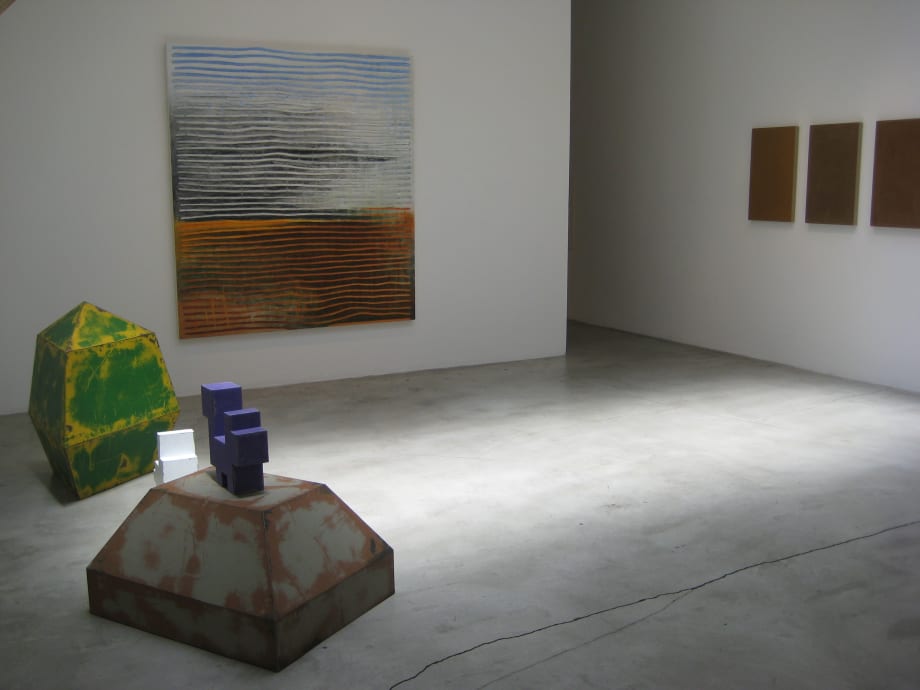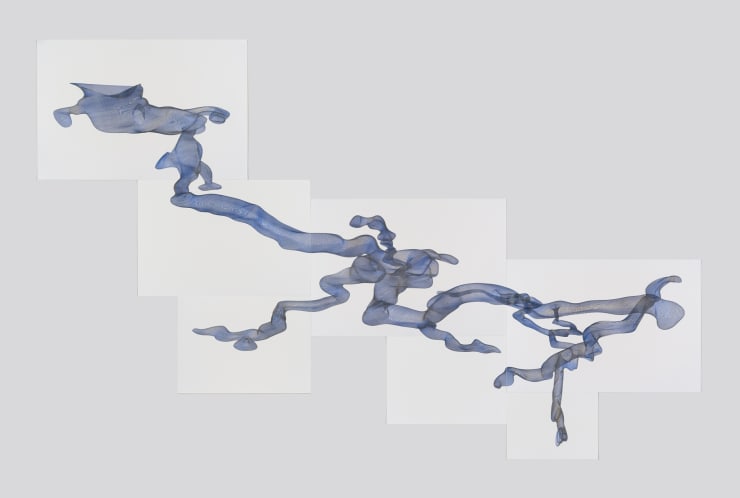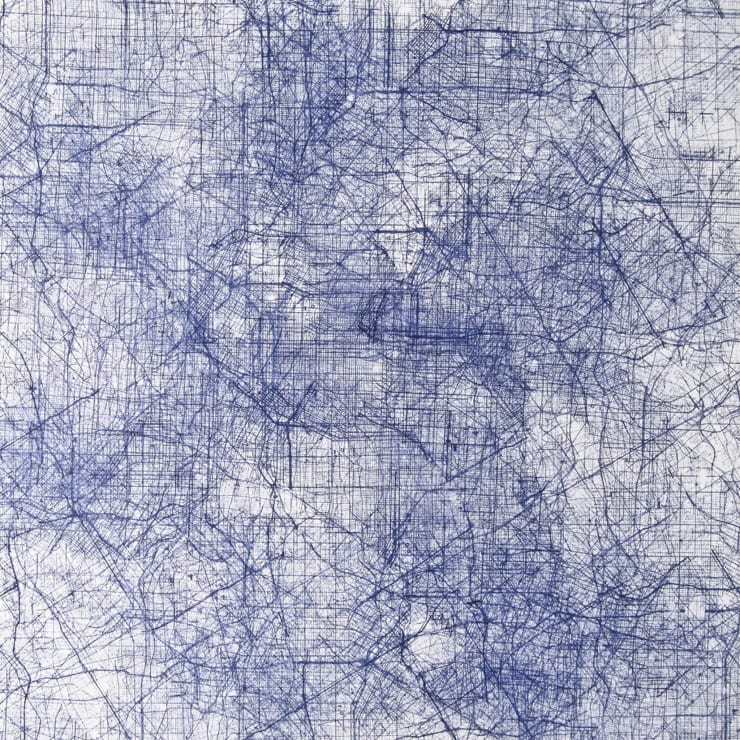TOPO/GRAPHY
Edward Cella Art & Architecture is pleased to present TOPO/GRAPHY, an exhibition that investigates the mapping of the relief, stratigraphy and history of land. In this presentation, nine contemporary artists explore the land as muse, becoming explorers, excavators, and surveyors through abstraction, line and process. A multi-media presentation of paintings, sculptures, ceramics, and drawings, TOPO/GRAPHY ultimately considers how human beings position themselves within an evolving and increasingly complex world.
Edward Cella Art & Architecture is pleased to present TOPO/GRAPHY, an exhibition that investigates the mapping of the relief, stratigraphy and history of land. In this presentation, nine contemporary artists explore the land as muse, becoming explorers, excavators, and surveyors through abstraction, line and process. A multi-media presentation of paintings, sculptures, ceramics, and drawings, TOPO/GRAPHY ultimately considers how human beings position themselves within an evolving and increasingly complex world.
Cris Bruch’s Bramble began as a 2-D aerial plan of the artist's father's life work in housing development in Kansas. Through the primary form of wall-based steel sculptures, Bramble represents the cul-de-sacs, utility sites, drives and driveways of suburban development. Bruch’s fluid and contorting works are evocative of the twisted helix strands of DNA, becoming suggestive of the familial and pointing to the complex relations between father and son, while linking them to the planning and expectations of suburban life, and the complicated visions of the American Dream.
Abandoning the traditional paintbrush, Mary Heebner dips her hands directly into dry minerals and wet pigments to form bold silhouettes of ancient vessels. While sketching ancient Mapuche pottery in Chilean Patagonia for a project entitled, Unearthed, Heebner noted fingerprints that traced across the thousand-year-old curved clay surfaces. For the artist, the physical act of forming these hand-paintings is itself a meditation on these ancient cultures and their remote environs. Her intuitive understanding reconnects to one of the earliest meanings of the topos graphia, or writing about place and history.
The minimalist paintings of Steve Schmidt are literally reduced to the elemental: pigments and canvas. Crafting his own tempera paints exclusively from hand-collected samples of rock and soil from excavations across Southern California; Schmidt is an artist/ geologist, registering the distinct and unique chromatic expressions inherent to each place. Charting his surveys, the title of each piece is determined by the GPS coordinate from the excavation’s exact locale, making his artworks uniquely site-specific.
The complex features and quantitative representations characteristic of topographic maps are dependent on the use of the line. Mexico based artist Davis Birks in particular explores the aesthetics of the science of topography in his visually intricate abstract drawings. His ongoing Spirals series is both exactingly complex and ethereally whimsical, a visual marriage of chance and exploration. The organic flowing shapes are suggestive of the never intersecting, concentric contour lines on a surveyor’s map.
Using CAD software and CNC (Computer Numerical Controls) technology to create his brilliantly colored, large-format line renderings, Seattle based artist Leo Saul Berk maps the interiors of caves and subterranean spaces to explore the significance of spiritually and politically charges places. During the events of 9/11, Berk was hiking towards Naj Tunich, a sacred cave in the remote jungles of Guatemala. To the ancient Maya, the cave was the entrance to the underworld. For Berk, mapping the negative space of the cave resulted in a visual metaphor of the strangely psychologically connected, political and societal shifts transpiring seemingly a world away.
Referencing the blueprint as a locus of dreams, Flora Kao accumulates overlays of the Los Angeles street grid creating imagined topographies that translate these everyday structures into systems of ethereal beauty. Employing a process that oscillates between accident and control, the handmade and mechanical, she plays with visual slippage, where the city grid dissipates into atmospherics.
Adam Silverman, founder of Los Angeles based Atwater Pottery, is represented by a selection of new sculptures. The wall-mounted boxes of assemblages of richly glazed clay objects that epitomize the artist’s exploration of carefully modulated relationships of scale, proximities, and rich surface textures. As such, the boxes act as a frame for compositions that are in and of themselves an undulating terrain in which each feature is distinguished by distinct geological and mineralogical processes.
Based on direct and intimate observation of the land, Brian Hollister transforms his frequent and extensive hikes through the backcountry of California and the greater Southwest into luminous and richly colored paintings. Composed of alternating, rhythmic lines of color, Hollister orients his marks horizontally across the canvas in a manner that suggests the land’s stratigraphic record and the brilliant light reflecting off its features.
Constructed of sheets of raw steel and heavily burnished automotive paints, Michael Whiting creates a landscape within the gallery interpreted though the pixilated vocabulary of early computer gaming. Simplifying the elements of nature to their most reductive forms, Whiting extracts a connection between the language of early Minimalist sculpture and the advent of developing computer technologies. It is an understanding began through the experiences unique to his generation, and is a reminder of the circuitous route of the development of an ever changing world view.
-
 Adam Silverman, Equation Series, 11.2, 2011
Adam Silverman, Equation Series, 11.2, 2011 -
 Adam Silverman, Equation Series, 11.5, 2011
Adam Silverman, Equation Series, 11.5, 2011 -
 Adam Silverman, Equation Series, 11.7, 2011
Adam Silverman, Equation Series, 11.7, 2011 -
 Adam Silverman, Equation Series, 11.6, 2011
Adam Silverman, Equation Series, 11.6, 2011 -
 Adam Silverman, Equation Series, 11.3, 2011
Adam Silverman, Equation Series, 11.3, 2011 -
 Adam Silverman, Equation Series, 11.4, 2011
Adam Silverman, Equation Series, 11.4, 2011 -
 Adam Silverman, Equation Series, 11.1, 2011
Adam Silverman, Equation Series, 11.1, 2011 -
 Davis Birks, Spiral 69, 2010
Davis Birks, Spiral 69, 2010 -
 Davis Birks, Spiral 71, 2010
Davis Birks, Spiral 71, 2010 -
 Mary Heebner, Patagonia Unearthed Series, Indigo Vessel #1, 2011
Mary Heebner, Patagonia Unearthed Series, Indigo Vessel #1, 2011 -
 Mary Heebner, Patagonia Unearthed Series, Indigo Vessel #4, 2011
Mary Heebner, Patagonia Unearthed Series, Indigo Vessel #4, 2011 -
 Leo Saul Berk, Dark House, 2008
Leo Saul Berk, Dark House, 2008 -
 Leo Saul Berk, River Full of Blood, 2008
Leo Saul Berk, River Full of Blood, 2008 -
 Cris Bruch, Bramble, 2007
Cris Bruch, Bramble, 2007 -
 Michael Whiting, Puppy (Yellow over Red), 2011
Michael Whiting, Puppy (Yellow over Red), 2011 -
 Michael Whiting, Blue Bird, 2011
Michael Whiting, Blue Bird, 2011 -
 Michael Whiting, Mushroom (Red Orange over Orange), 2011
Michael Whiting, Mushroom (Red Orange over Orange), 2011 -
 Michael Whiting, Mushroom (Purple over Blue), 2011
Michael Whiting, Mushroom (Purple over Blue), 2011 -
 Michael Whiting, Mushroom (Gray over Green), 2011
Michael Whiting, Mushroom (Gray over Green), 2011 -
 Michael Whiting, Mushroom (White over Yellow), 2011
Michael Whiting, Mushroom (White over Yellow), 2011 -
 Michael Whiting, Sun, 2007
Michael Whiting, Sun, 2007 -
 Michael Whiting, Purple Squirrel, 2011
Michael Whiting, Purple Squirrel, 2011 -
 Michael Whiting, Rock, 2007
Michael Whiting, Rock, 2007 -
 Michael Whiting, White Rabbit, 2011
Michael Whiting, White Rabbit, 2011 -
 Michael Whiting, Shrub, 2007
Michael Whiting, Shrub, 2007 -
 Steve Schmidt, Refugio Gold (34.4611,-120.073646), 2011
Steve Schmidt, Refugio Gold (34.4611,-120.073646), 2011 -
 Steve Schmidt, Happy Isle (37.72983,-119.559145), 2011
Steve Schmidt, Happy Isle (37.72983,-119.559145), 2011 -
 Steve Schmidt, Nevada Falls (37.725379,-119.53125), 2011
Steve Schmidt, Nevada Falls (37.725379,-119.53125), 2011 -
 Steve Schmidt, Yuma red (32.920664,-114.322443), 2011
Steve Schmidt, Yuma red (32.920664,-114.322443), 2011 -
 Steve Schmidt, Sequoia Black (37.518276,-119.600003), 2011
Steve Schmidt, Sequoia Black (37.518276,-119.600003), 2011 -
 Brian Hollister, Untitled LIV (54), 2008
Brian Hollister, Untitled LIV (54), 2008 -
 Brian Hollister, Ruggedy, 2008
Brian Hollister, Ruggedy, 2008 -
 Brian Hollister, Latent and Blatant, 2010
Brian Hollister, Latent and Blatant, 2010 -
 Flora Kao, Lines of Desire, 2011
Flora Kao, Lines of Desire, 2011 -
 Flora Kao, Trace (Los Angeles), Set of 9, 2011
Flora Kao, Trace (Los Angeles), Set of 9, 2011









































